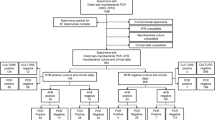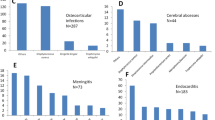Abstract
Molecular methods have been considered to be the gold standard for the diagnosis of infectious lymphadenitis. However, culture remains critical in the case of low bacterial concentrations. We used molecular assays and culture to examine fresh lymph node biopsies from patients with suspected infectious lymphadenopathy. We analyzed 1762 lymph node biopsies of which 522 (30%) samples were found positive by real-time PCR; the most commonly amplified bacteria were Bartonella henselae (n = 438, 84%), Francisella tularensis (n = 46, 9%), and Mycobacterium spp. (n = 29, 6%). PCR amplification and sequencing of the 16S rDNA were positive for 359 (20%) lymph node specimens including mainly B. henselae (n = 167, 47%), Staphylococcus spp. (n = 77, 21%), and Streptococcus spp. (n = 41, 11%). In total, 351 lymph nodes were cultured on agar plates and 77 (22%) were positive. Significantly more lymph nodes infected by Gram-positive easy-growing agents were diagnosed by culture (n = 45) than by 16S rDNA PCR (p = 0.02). Culture remains critical for the diagnosis of easy-growing bacteria and mycobacteria; clinicians should be aware that a negative molecular result does not imply absence of infection.


Similar content being viewed by others
References
Gaddey H, Riegel A (2016) Unexplained lymphadenopathy: evaluation and differential diagnosis. Am Fam Physician 94:896–903
Lucas SB (2017) Lymph node pathology in infectious diseases. Diagn Histopathol 23:420–430. https://doi.org/10.1016/j.mpdhp.2017.07.002
Ridder GJ, Boedeker CC, Technau-Ihling K, Grunow R, Sander A (2002) Role of cat-scratch disease in lymphadenopathy in the head and neck. Clin Infect Dis 35:643–649. https://doi.org/10.1086/342058
Angelakis E, Roux V, Raoult D, Rolain J-M (2009) Real-time PCR strategy and detection of bacterial agents of lymphadenitis. Eur J Clin Microbiol Infect Dis 28:1363–1368. https://doi.org/10.1007/s10096-009-0793-6
Polesky A, Grove W, Bhatia G (2005) Peripheral tuberculous lymphadenitis: epidemiology, diagnosis, treatment, and outcome. Medicine (Baltimore) 84:350. https://doi.org/10.1097/01.md.0000189090.52626.7a
Wagner D, Young LS (2004) Nontuberculous mycobacterial infections: a clinical review. Infection 32:257–270. https://doi.org/10.1007/s15010-004-4001-4
Reuss A, Drzymala S, Hauer B, von Kries R, Haas W (2017) Treatment outcome in children with nontuberculous mycobacterial lymphadenitis: a retrospective follow-up study. Int J Mycobacteriol 6:76–82. https://doi.org/10.4103/2212-5531.201898
Fellner A, Marom T, Muallem-Kalmovich L, Shlamkovitch N, Eviatar E et al (2017) Pediatric neck abscesses: no increase in methicillin-resistant Staphylococcus aureus. Int J Pediatr Otorhinolaryngol 101:112–116. https://doi.org/10.1016/j.ijporl.2017.07.021
Kelly CS, Kelly RE (1998) Lymphadenopathy in children. Pediatr Clin N Am 45:875–888. https://doi.org/10.1016/S0031-3955(05)70051-1
Sutera V, Hoarau G, Renesto P, Caspar Y, Maurin M (2017) In vitro and in vivo evaluation of fluoroquinolone resistance associated with DNA gyrase mutations in Francisella tularensis, including in tularaemia patients with treatment failure. Int J Antimicrob Agents. https://doi.org/10.1016/j.ijantimicag.2017.03.022
Foucault C, Lepidi H, Poujet-Abadie JF, Granel B, Roblot F et al (2004) Q fever and lymphadenopathy: report of four new cases and review. Eur J Clin Microbiol Infect Dis 23:759–764. https://doi.org/10.1007/s10096-004-1211-8
Chizinga M, Schiliro D, Mullin B, Barrie RL (2017) Mesenteric lymphadenitis as a presenting feature of Whipple’s disease. IDCases 9:50–52. https://doi.org/10.1016/j.idcr.2017.06.002
Grossman MM, Shiramizu BM (1994) Evaluation of lymphadenopathy in children. Curr Opin Pediatr 6:68
Lagier J-C, Edouard S, Pagnier I, Mediannikov O, Drancourt M, Raoult D (2015) Current and past strategies for bacterial culture in clinical microbiology. Clin Microbiol Rev 28:208–236. https://doi.org/10.1128/CMR.00110-14
Rolain J-M, Lepidi H, Zanaret M, Triglia J-M, Michel G et al (2006) Lymph node biopsy specimens and diagnosis of cat-scratch disease. Emerg Infect Dis 12:1338–1344. https://doi.org/10.3201/eid1209.060122
Sander A, Posselt M, Böhm N, Ruess M, Altwegg M (1999) Detection of Bartonella henselae DNA by two different PCR assays and determination of the genotypes of strains involved in histologically defined cat scratch disease. J Clin Microbiol 37:993–997
Lagier J-C, Hugon P, Khelaifia S, Fournier P-E, La Scola B, Raoult D (2015) The rebirth of culture in microbiology through the example of culturomics to study human gut microbiota. Clin Microbiol Rev 28:237–264. https://doi.org/10.1128/CMR.00014-14
Hugon P, Lagier J-C, Robert C, Lepolard C, Papazian L et al (2013) Molecular studies neglect apparently gram-negative populations in the human gut microbiota. J Clin Microbiol 51:3286–3293. https://doi.org/10.1128/JCM.00473-13
Lagier J-C, Drancourt M, Charrel R, Bittar F, La Scola B et al (2017) Many more microbes in humans: enlarging the microbiome repertoire. Clin Infect Dis 65:S20–S29. https://doi.org/10.1093/cid/cix404
Safont M, Angelakis E, Richet H, Lepidi H, Fournier P-E et al (2014) Bacterial lymphadenitis at a major referral hospital in France from 2008 to 2012. J Clin Microbiol 52:1161–1167. https://doi.org/10.1128/JCM.03491-13
Morel A-S, Dubourg G, Prudent E, Edouard S, Gouriet F et al (2014) Complementarity between targeted real-time specific PCR and conventional broad-range 16S rDNA PCR in the syndrome-driven diagnosis of infectious diseases. Eur J Clin Microbiol Infect Dis 34:561–570. https://doi.org/10.1007/s10096-014-2263-z
Prudent E, Lepidi H, Audoly G, Scola BL, Fournier P-E, Edouard S, Angelakis E, Raoult D (2017) Bartonella henselae is usually not viable in lymph nodes of patients with cat scratch disease. Eur J Clin Microbiol Infect Dis 36:2207–2213. https://doi.org/10.1007/s10096-017-3047-z
Eldin C, Angelakis E, Renvoisé A, Raoult D (2013) Coxiella burnetii DNA, but not viable bacteria, in dairy products in France. Am J Trop Med Hyg 88:765–769. https://doi.org/10.4269/ajtmh.12-0212
Bruijnesteijn van Coppenraet ES, Lindeboom JA, Prins JM, Peeters MF et al (2004) Real-time PCR assay using fine-needle aspirates and tissue biopsy specimens for rapid diagnosis of mycobacterial lymphadenitis in children. J Clin Microbiol 42:2644–2650. https://doi.org/10.1128/JCM.42.6.2644-2650.2004
Drancourt M, Bollet C, Carlioz A, Martelin R, Gayral J-P, Raoult D (2000) 16S ribosomal DNA sequence analysis of a large collection of environmental and clinical unidentifiable bacterial isolates. J Clin Microbiol 38:3623–3630
Gouriet F, Fenollar F, Patrice J-Y, Drancourt M, Raoult D (2005) Use of shell-vial cell culture assay for isolation of bacteria from clinical specimens: 13 years of experience. J Clin Microbiol 43:4993–5002. https://doi.org/10.1128/JCM.43.10.4993-5002.2005
Marrero M, Raoult D (1989) Centrifugation-shell vial technique for rapid detection of Mediterranean spotted fever rickettsia in blood culture. Am J Trop Med Hyg 40:197–199. https://doi.org/10.4269/ajtmh.1989.40.197
Drancourt M, Raoult D (2007) Cost-effectiveness of blood agar for isolation of mycobacteria. PLoS Negl Trop Dis 1:e83. https://doi.org/10.1371/journal.pntd.0000083
Drancourt M, Carrieri P, Gévaudan M-J, Raoult D (2003) Blood agar and Mycobacterium tuberculosis: the end of a dogma. J Clin Microbiol 41:1710–1711. https://doi.org/10.1128/JCM.41.4.1710-1711.2003
Centers for Disease Control and Prevention/National Institutes of Health (1993) Biosafety in microbiological and biomedical laboratories. https://stacks.cdc.gov/view/cdc/13366. Accessed 21 Sep 2017
Zingue D, Flaudrops C, Drancourt M (2016) Direct matrix-assisted laser desorption ionisation time-of-flight mass spectrometry identification of mycobacteria from colonies. Eur J Clin Microbiol Infect Dis 35:1983–1987. https://doi.org/10.1007/s10096-016-2750-5
Seng P, Drancourt M, Gouriet F, La Scola B, Fournier P-E et al (2009) Ongoing revolution in bacteriology: routine identification of bacteria by matrix-assisted laser desorption ionization time-of-flight mass spectrometry. Clin Infect Dis 49:543–551. https://doi.org/10.1086/600885
Lakos A (2002) Tick-borne lymphadenopathy (TIBOLA). Wien Klin Wochenschr 114:648–654
Ibarra V, Oteo JA, Portillo A, Santibáñez S, Blanco J r et al (2006) Rickettsia slovaca infection: DEBONEL/TIBOLA. Ann N Y Acad Sci 1078:206–214. https://doi.org/10.1196/annals.1374.040
Varona JF, Guerra JM, Guillén V, Guillén S, Menassa A, Palenque E (2002) Isolated cervical lymphadenopathy as unique manifestation of brucellosis. Scand J Infect Dis 34:538–540. https://doi.org/10.1080/003655402320208802
van CR, Grefte JMM, van DD, Sturm P (2009) Syphilis presenting as isolated cervical lymphadenopathy: two related cases. J Inf Secur 58:76–78. https://doi.org/10.1016/j.jinf.2008.06.006
McCabe RE, Brooks RG, Dorfman RF, Remington JS (1987) Clinical spectrum in 107 cases of toxoplasmic lymphadenopathy. Rev Infect Dis 9:754–774. https://doi.org/10.1093/clinids/9.4.754
Barral A, Guerreiro J, Bomfim G, Correia D, Barral-Netto M, Carvalho EM (1995) Lymphadenopathy as the first sign of human cutaneous infection by Leishmania braziliensis. Am J Trop Med Hyg 53:256–259. https://doi.org/10.4269/ajtmh.1995.53.256
Norman FF, Monge-Maillo B, Perez-Molina J-A, De Ory F, Franco L et al (2015) Lymphadenopathy in patients with chikungunya virus infection imported from Hispaniola: case reports. J Travel Med 22:272–275. https://doi.org/10.1111/jtm.12204
Weitzel T, Cortes CP (2016) Zika virus infection presenting with postauricular lymphadenopathy. Am J Trop Med Hyg 95:255–256. https://doi.org/10.4269/ajtmh.16-0096
Dupon M, Larclause ASD, Brouqui P, Drancourt M, Raoult D et al (1996) Evaluation of serological response to Bartonella henselae, Bartonella quintana and Afipia felis antigens in 64 patients with suspected cat-scratch disease. Scand J Infect Dis 28:361–366. https://doi.org/10.3109/00365549609037920
Angelakis E, Armougom F, Million M, Raoult D (2011) The relationship between gut microbiota and weight gain in humans. Future Microbiol 7:91–109. https://doi.org/10.2217/fmb.11.142
Lagier J-C, Armougom F, Million M, Hugon P, Pagnier I et al (2012) Microbial culturomics: paradigm shift in the human gut microbiome study. Clin Microbiol Infect 18:1185–1193. https://doi.org/10.1111/1469-0691.12023
Freidig EE, McClure SP, Wilson WR, Banks PM, Washington JA (1986) Clinical-histologic-microbiologic analysis of 419 lymph node biopsy specimens. Rev Infect Dis 8:322–328. https://doi.org/10.1093/clinids/8.3.322
Doberneck RC (1983) The diagnostic yield of lymph node biopsy. Arch Surg 118:1203–1205. https://doi.org/10.1001/archsurg.1983.01390100067017
Roberts FJ, Linsey S (1984) The value of microbial cultures in diagnostic lymph-node biopsy. J Infect Dis 149:162–165. https://doi.org/10.1093/infdis/149.2.162
Dolan MJ, Wong MT, Regnery RL, Jorgensen JH, Garcia M, Peters J, Drehner D (1993) Syndrome of Rochalimaea henselae adenitis suggesting cat scratch disease. Ann Intern Med 118:331–336. https://doi.org/10.7326/0003-4819-118-5-199303010-00002
Demers DM, Bass JW, Vincent JM, Person DA, Noyes DK et al (1995) Cat-scratch disease in Hawaii: etiology and seroepidemiology. J Pediatr 127:23–26. https://doi.org/10.1016/S0022-3476(95)70251-2
Wong MT, Thornton DC, Kennedy RC, Dolan MJ (1995) A chemically defined liquid medium that supports primary isolation of Rochalimaea (Bartonella) henselae from blood and tissue specimens. J Clin Microbiol 33:742–744
Acknowledgments
We would like to thank Gregory Mougel for his help with data collection.
Author information
Authors and Affiliations
Corresponding author
Ethics declarations
Conflict of interest
The authors declare that they have no conflicts of interest.
Ethical approval
Ethical approval was not required.
Informed consent
No informed consent was required since this was a retrospective study.
Electronic supplementary material
ESM 1
(DOCX 23 kb)
Rights and permissions
About this article
Cite this article
Prudent, E., La Scola, B., Drancourt, M. et al. Molecular strategy for the diagnosis of infectious lymphadenitis. Eur J Clin Microbiol Infect Dis 37, 1179–1186 (2018). https://doi.org/10.1007/s10096-018-3238-2
Received:
Accepted:
Published:
Issue Date:
DOI: https://doi.org/10.1007/s10096-018-3238-2




